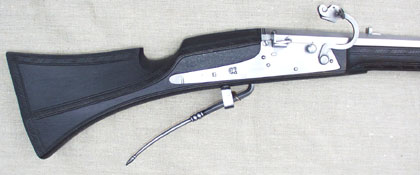Original made in Suhl, between 1610 and 1620 (proofmark: SVL).
Total length: 130 cm
Barrel length: 97,5 cm
Weight: 3 kg
Smooth bore barrel with a barrel calibre of 16mm (20 balls to the pound), made for shooting a rolling bullet of 14,9 mm (24 balls to the pound Nurnberg silver-weight).
High quality matchlook, equipped with a trigger lever, which was in use until the early years of the seventeenth century. Differently to the usual musket and caliver lock designs, that use a pivot pan cover, this lock has a spring loaded sliding pan cover, which can be closed by pressing a spring pin at the side of the lockplate.
The barrel features an octagonal outer shape, slightly tapered towards the muzzle. The sights consist of a dovetail notch and a soldered bead.
Blackened and oiled beech stock, with decorative linear carvings at the edges. Wooden ramrod with metal tip, embedded into the front stock without using ramrod bands.
Beside the heavy and sometimes cumbersome muskets, also lighter versions of firearms were used during the thirty years wars, so called calivers (in german/dutch/swedish called Rohre/roers/rör, not to be confused with the term Rohre or roers, which term was also used for single barrels). Calivers had smoothbore barrels, a total average length of about 130 to 135 cm, weighted less than 4 kg and in Germany, among other cities, were produced in Suhl, Nurnberg and Essen. They were often bored to a calibre of 20 bullets to the pound Nurnberg silver weight (about 15,9 mm) and fired a bullet rolling in of 24 to the pound (14,9 mm). Light calivers could be shot without using a rest and were used by so called calivermen (in german Schützen or Rohrschützen). Caliverman did not carry a powder bandolier, but instead carried some sort of leather device or tongue attached to the belt, which held a curved powder flask, a small priming flask and a bullet pouch (in german this device was called Flaschenhangsel or Porteflask). Calivermen already were abandoned from the field army in the early years of the 17th century. While Jacob de Gheyn in his exercise intruction from 1607/08 still talks about "Rören, Musquetten undt Spiessen" (calivers, muskets and pikes), Johann Jacobi von Wallhausen in 1615 judges about the plain caliver: "Every captain should endeavour after having mostly musketeers, and not boys, that he has to burry with calivers or other sort of light firearms, intead get his calivermen accustomed to carry a forquette together with the caliver, so it will be an easy exercise for them to handle the musket later on." The military exercise booklet of Peter Isselburg, published in Nurnberg in 1620 does not even mention calivermen any more. Calivers as a category of firearms hovever continued to play an important role throughout the war, as they were stocked in the arsenals of larger and smaller cities in large quantities and thus continued to be an important armament of the city militias, as they were much easier to be handled on walls and other fortifications as muskets.

This sight of the rear stock and butt area showes the lineary carved edges and contours of the stock , which provide a decorative appearance to this wapon.
The built in matchlook with opened flash pan. Unusual for a matchlock is the sophisticated spring-loaded sliding pan cover, which is applied here instead of the pivoting pan covers normally attached to this kind of locks. By pressing the button located beyond the sliding cover, the flash pan is automatically closed.
Muzzle area of the caliver. Recognizable is the throughout octagonally shaped barrel and the decorative carvings up to the nose of the stock. The ramrod is not held in position by the usual metal bands, but by a wooden pipe. The ramrod tip, exactly designed as the original, consists of a soldered metal shell with an threaded insert for installation of a cleanung jag, bullet puller or worm.
Inner view of the lock. The fairly simple but at the same time very precise and functional machanism secures a high degree of reliability. Most of the inner space is used by the spring-loaded pan sliding cover.
Detail of lock and powder chamber with opened flash pan from above. The original Suhl master and proof marks have been replaced by the marks of Armin Koenig.
Back to Firearms